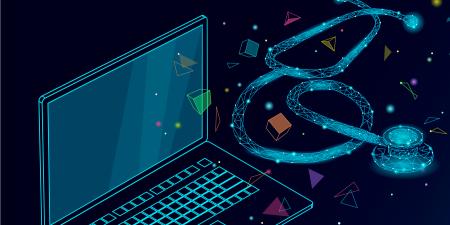Physician shortages and ever-increasing patient volume are longstanding problems in medicine. The problem is particularly acute in specialties such as dermatology and dermatopathology: dermatologists account for only 1 percent of US physicians and are underrepresented in resource-constrained areas [1, 2]. In developing countries, rural and displaced communities, and regions affected by war, natural disasters, epidemics, and influxes of immigrants and refugees, these shortages of doctors are even more severe [3].
Telemedicine provides a consultation platform for triage, diagnosis, and management decisions and plays a fundamental role in humanitarian efforts to increase access to care in remote areas, reduce health inequities, and strengthen health systems in the developing world [4]. The increasing use of information and communication technologies is transforming medicine and amplifying access to expertise to relieve suffering in areas of greatest need.
The Evolution of Telemedicine
The use of telemedicine to offer relief services should by no means be labeled an invention only of the late twentieth century; the vast array of health telematics applications available today has roots in the past. For instance, the 1920 founding of a seafarers’ medical advice service that employed Morse code and radio [5] was cutting-edge for its time. Although very basic by modern standards, such technologies have a common denominator: seeking to resolve health needs, regardless of distance, by utilizing the most state-of-the-art technologies available. Telemedicine has evolved to incorporate the transmission of highly visual media such as pathology slides and images of affected areas of the body in real time or via a store-and-forward system.
The evolving communication and computing technologies are challenging the traditional conception of the patient-physician relationship [6]. Can an ideal therapeutic relationship exist in the absence of real-life contact? Will physical distance accelerate a trend towards a more cognitive, less caring model of the health system? Will telemedicine allow rural residents to rely more heavily on local clinicians with similar cultural backgrounds, who will then communicate with urban specialists on behalf of their patients? As these big questions are being debated, telemedicine serves the practical needs of those in places with inadequate local medical services.
In resource-limited settings, remote consultations and review of difficult cases increase the likelihood of definitive diagnosis and guide appropriate clinical management. Mobile telephone consultations have been shown to be feasible and acceptable to patients in developing countries [7-9]; they offer solutions for emergency medical assistance and guidance in the prioritization of care and more equitable allocation of scarce resources. Telemedicine network partnerships between fledgling health centers and remote clinicians are a valuable tool for capacity-building, supervision, quality assurance, and mobile training. Such partnerships are also useful for education of ancillary health care professionals to promote sustainability in areas that are developing self-reliance.
Potential Concerns about Telehealth
Despite the benefits of telemedicine for advancing humanitarian services, there are also areas of concern.
Troubling are potential confidentiality risks posed by “data intruders,” whose motivations range from research and forensic needs to marketing, insurance, or employment decisions. Strong ethical concerns also exist about research based on electronic medical records or video recordings of teleconsultations and who will have access to them. If not monitored, such research can deviate from humanitarian goals and violate the moral imperatives to preserve confidentiality and secure informed consent from research participants.
With the growth of telemedicine, more clinical tasks, such as health monitoring and submission of cases for teleconsultation, are being entrusted to ancillary health workers [10]. It’s debatable whether physicians’ obligations extend beyond clear and timely communication of opinions. Does humanitarian work exempt doctors from normal legal responsibility for the patient and the acts of the referring medical personnel [11]? How should medical malpractice liability be apportioned if errors are made by intermediaries in the transmission and execution of specialists’ recommendations?
Also, the quality of the information shared electronically may be compromised by patients’ limited health literacy and communication skills, raising concern that treatment may be based on inaccurate or incomplete patient information. Given the limitations of the videoconferencing equipment, a thorough physical exam cannot be completed. Some studies have validated the use of videoconferencing by demonstrating high rates of concordance between diagnoses given after remote and face-to-face consultations [12-14]. However, these studies do not take into account the varying levels of health education and communication ability of patients who need humanitarian services.
On a policy level, humanitarian telemedicine may create conflict if issues of physician shortages are also not addressed in resource-limited areas. Will resource allocation decisions result in the poorest of the poor being “screened out” from in-person doctor visits? Telemedicine cannot completely replace physician visits; rather, they need to be considered an adjunct to the current system.
Looking Ahead
The number of people around the world who, as a result of natural and manmade disasters, political violence, or epidemics, need specialty medical care is growing steadily, and telemedicine is quickly becoming a field that can relieve that burden. The increasing popularity of telemedicine aid calls for establishment of international standards and protocols so that patients receive the best quality care possible [15]. Clearly, more studies are needed to develop best practices and techniques specific to services in low-resource environments.
To protect all parties from exploitation, legislation should be enacted to delineate responsibilities and apportion liability when medical misadventure occurs as a result of mistakes made at various levels by referring medical personnel, health informatics professionals, expatriate specialists, and patients. Ideally, telehealth protocols should be structured to acknowledge these responsibilities and liabilities.
Detailed counseling should be provided and informed consent sought prior to the creation of an electronic health record. To manage the jurisdictional problems associated with the use of telemedicine data, institutional review boards should ensure that their committee members have expertise that enables thorough reviews of studies to protect research participants’ confidentiality.
Because the ability to deliver humanitarian services via telemedicine is often hampered by unreliable Internet connectivity, improving interaction between networks will strengthen IT infrastructure and improve sustainability [16].
To prepare physicians to deliver excellent telecare, it is also vital that residency training programs develop a formal informatics curriculum that covers topics such as digital imaging, electronic medical records, information security and privacy, and clinical decision support systems. A well-rounded education should include mastering the art of safe, ethical, and socioculturally and politically sensitive telemedicine [17]. Physicians should also be aware of the local culture, diseases, and resources available at the site of the patient to provide the best care.
Conclusion—a Delicate Balance
Medicine and public health benefit by deploying the expert skills of professionals in remote patient-physician encounters to improve health care delivery and overcome barriers of geography, professional availability, limited transportation and infrastructure, and socioeconomic status. On the flip side, employing the revolutionary technology of telemedicine in underserved settings has profound technical, legal, and sociopolitical implications. These issues must be resolved for this evolving method to have the pragmatic and therapeutic success it promises. Today, the realization of this promise seems to be in our future.
References
-
Smart DR; American Medical Association. Physician Characteristics and Distribution in the US: 2012. Chicago, IL: American Medical Association Press; 2012.
- Tsang MW, Kovarik CL. Global access to dermatopathology services: physician survey of availability and needs in sub-Saharan Africa. J Am Acad Dermatol. 2010;63(2):346-348.
-
Ajami S, Lamoochi P. Use of telemedicine in disaster and remote places. J Educ Health Promot. 2014;3.
-
Wootton R, Patil NG, Scott RE, Ho K, eds. Telehealth in the Developing World. London: Royal Society of Medicine Press; 2009.
-
Amenta F, Rizzo N. Maritime radiomedical services. In: Wootton R, ed. European Telemedicine 1998/99. London: Kensington Publications; 1999:125-126.
- Miller EA. The technical and interpersonal aspects of telemedicine: effects on doctor–patient communication. J Telemed Telecare. 2003;9(1):1-7.
- Tran K, Ayad M, Weinberg J, et al. Mobile teledermatology in the developing world: implications of a feasibility study on 30 Egyptian patients with common skin diseases. J Am Acad Dermatol. 2011;64(2):302-309.
- Ebner C, Wurm EM, Binder B, et al. Mobile teledermatology: a feasibility study of 58 subjects using mobile phones. J Telemed Telecare. 2008;14(1):2-7.
- Azfar RS, Weinberg JL, Cavric G, et al. HIV-positive patients in Botswana state that mobile teledermatology is an acceptable method for receiving dermatology care. J Telemed Telecare. 2011;17(6):338-340.
- Clark AR, Monroe JR, Feldman SR, Fleischer AB Jr, Hauser DA, Hinds MA. The emerging role of physician assistants in the delivery of dermatologic health care. Dermatol Clin. 2000;18(2):297-302.
-
Nestor MS. The use of mid-level providers in dermatology: a liability risk? Semin Cutan Med Surg. 2005;249(3):148-151.
- Gimbel DC, Sohani AR, Prasad Busarla SV, et al. A static-image telepathology system for dermatopathology consultation in East Africa: the Massachusetts General Hospital experience. J Am Acad Dermatol. 2012;67(5):997-1007.
- Leinweber B, Massone C, Kodama K, et al. Teledermatopathology: a controlled study about diagnostic validity and technical requirements for digital transmission. Am J Dermatopathol. 2006;28(5):413-416.
-
Al Habeeb A, Evans A, Ghazarian D. Virtual microscopy using whole-slide imaging as an enabler for teledermatopathology: a paired consultant validation study. J Pathol Inform. 2012;3:2. doi:10.4103/2153-3539.93399.
- Wootton R, Geissbuhler A, Jethwani K, et al. Long-running telemedicine networks delivering humanitarian services: experience, performance and scientific output. Bull World Health Organ. 2012;90(5):341D-347D.
- Kokolakis S, Gritzalis D, Katsikas S. Why we need standardisation in health care security. Stud Health Technol Inform. 2002;69(7):7-12.
- Doarn CR, Merrell RC. Telemedicine and e-health in disaster response. Telemed J E Health. 2014;20(7):605-606.



